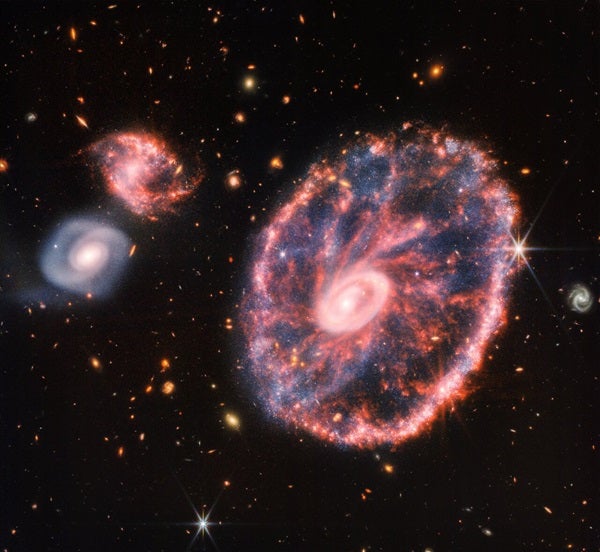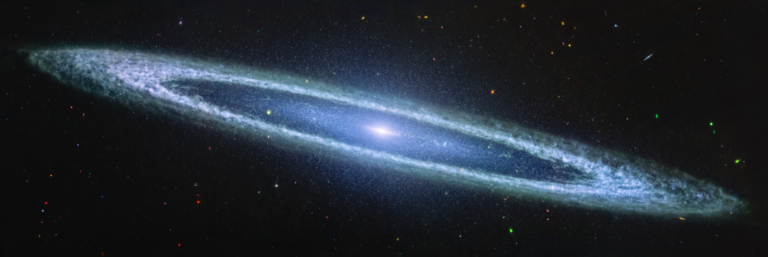The universe is a dynamic and, at times, violent place. Galaxies often crash into each other, sometimes merging together to form something new and other times only leaving behind the dramatic signs of their passage.
The Cartwheel Galaxy underwent just such a cosmic smash-up several hundred million years ago, when a smaller galaxy punched right through its center. The collision has profoundly changed the galaxy’s structure and nature, transforming it from a run-of-the-mill spiral like the Milky Way into a rarer ring-type galaxy with a bright core and two concentric rings linked by wispy “spokes,” which evoke the Cartwheel’s namesake.
Now, the James Webb Space Telescope (JWST) has turned its massive, infrared-seeking eye on the Cartwheel (right) and two of its companions (left). Myraid distant galaxies float in the background, much farther away. This stunning composite, which contains images taken with the Mid-InfraRed Instrument (MIRI) and Near-InfraRed Camera (NIRCam), reveals new details about how the Cartwheel has evolved since the collision, highlighting differences between its inner and outer regions. These present-day differences offer a way to trace the galaxy’s star-formation history to uncover clues about its past.
JWST’s NIRCam observes at infrared wavelengths, which are perfect for homing in on pockets of star formation, which appear blue here. (Additional NIRCam data are colored orange and yellow.) Most of the galaxy’s news stars are forming in its clumpy outer ring, which is still expanding into space. As the ring collides with surrounding intergalactic material, it triggers yet more star births. By contrast, though the galaxy’s older, inner region is home to massive clusters of young stars, it also contains a smoother distribution of ample dust and older stars as well. The core also contains an excess of hot dust and gas that astronomers think could be falling back into the galaxy after being thrown out of the plane during the collision.
Additionally, MIRI data (colored red) reveal the spokes linking the Cartwheel’s inner and outer rings more clearly than ever before. These structures are composed of dust with complex chemistry, including hydrocarbons and silicates, similar to earthly dust, and could someday form the building blocks of new planetary systems within the galaxy. Look closely, and you’ll see that the spokes are slightly curved, indicating the galaxy’s spiral structure may be starting to re-emerge over time.
By combining NIRCam and MIRI data into a single image, the final result gives astronomers a clearer picture about the Cartwheel’s past and present, showing a galaxy in transition, still very much reeling from its past encounter.










